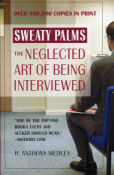| What REALLY goes on in a job interview? Find out in the new revision of "Sweaty Palms: The Neglected Art of Being Interviewed" (Warner Books) by Tony Medley, updated for the world of the Internet . Over 500,000 copies in print and the only book on the job interview written by an experienced interviewer, one who has conducted thousands of interviews. This is the truth, not the ivory tower speculations of those who write but have no actual experience. "One of the top five books every job seeker should read," says Hotjobs.com. | |
| Factory Girl (5/10) by Tony Medley I spent Easter of 1965 in New York City, driving up in my beloved 1960 Corvair during my third year at the University of Virginia Law School. At the same time, in the same place, 22-year-old Edie Sedgwick (Sienna Miller), a rich kid from a dysfunctional Santa Barbara family, met the bizarre Andy Warhol (Guy Pearce), changing her life. While Warhol did give her more than the15 minutes of fame he allotted everyone, she was also introduced to the drug addiction that would kill her. This is a stark, depressing telling of her story. In only three years, from 1965 to 1968, Sedgwick became a fashion icon and started her death spiral. Miller captures, if not exceeds, Edie’s extraordinary beauty. Her look, black tights, high heels, shift dresses, slinky tops, a blonde pixie cut, heavy black eye-shadow and dangling, chandelier earrings, influenced millions. Edie described her look herself, “When I was with Andy…I was dancing jazz ballet twice a day…and I knew I wasn’t going to turn anybody on so I just trotted around in my leotards…and then Vogue photographed me in leotards and t-shirts as a new costume.” Life Magazine commented in 1965, “This cropped-mop girl with the eloquent legs is doing more for black tights than anybody since Hamlet.” Edie was only with Andy for little more than a year. They split in 1966. As fashion maven Diana Vreeland said, “She was after life, but sometimes life doesn’t come fast enough.” Warhol himself said, “She always wanted to leave. Even if the party was good, she wanted to leave…Edie was like that. She just couldn’t wait to get to the next place.” Warhol had transformed a former downtown Manhattan hat factory into a bohemian paradise, which became known as The Factory. He used it to attract a rag-tag mix of musicians, poets, artists, actors and misfits (including people like poet Gerard Malanga, whom the New York Times called “Warhol’s most important associate”, art curator Sam Green, future rock music manager Danny Fields, and writer-raconteur George Plimpton) to create avant-garde movies during the day and throw glam parties through the night. In addition to Warhol, the film shows Edie with a hot relationship with an unnamed rock musician (Hayden Christensen). In real life, Edie had a crush on Bob Dylan, circa 1965-66, although whether or not it was consummated is controversial. She apparently did have a tumultuous romantic relationship with Dylan’s associate, singer-songwriter Bob Neuwirth, so Christensen’s character is unnamed because it is a composite. Unfortunately, this film concentrates on her short relationship with Warhol and Christensen and her subsequent death spiral, but doesn’t really show just exactly how she became the icon canonized by Life in such a short period of time. As a result, it seemed excruciatingly slow to me. Director George Hickenlooper and screenwriter Captain Mauzner completely miss the mark of what could have been an entertaining movie. The film drags through its 91 minutes. Even though Miller is beautiful and her performance in the drug scenes is reminiscent of Frank Sinatra’s “Man With the Golden Arm” (1955), and even though Pearce gives a stunning performance as Warhol, the film is monumentally disappointing, wasting Oscar-caliber performances by Miller and Pearce. If you’re there, stay for the closing credits and see comments on Edie by real life members of The Factory, including Plimpton, who were still alive when the film was made. February 1, 2007
|
|
|
|
|
